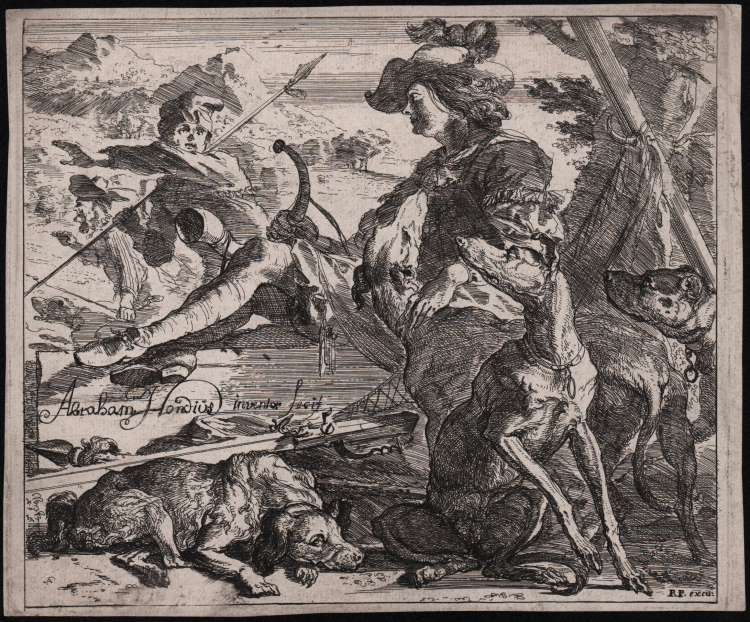



| Reference: | S42010 |
| Author | Abraham HONDIUS |
| Year: | 1672 |
| Measures: | 175 x 150 mm |


| Reference: | S42010 |
| Author | Abraham HONDIUS |
| Year: | 1672 |
| Measures: | 175 x 150 mm |
Etching, 1672, lower left, in the image, “Abraham Hondius inventor fecit; lower right “RT excu”.
Title-page with signature written on wooden planks at left, a huntsman holding a horn and sitting on top of the planks in the centre, four dogs in the foreground, two pikemen beyond, hills in the background at left; frontispiece to a series of seven plates showing animals.
Titlepage of a series of prints depicting hunting animals, printed in London, 1672, a second state with the address of Richard Thompson lower right.
Abraham Danielszoon Hondius, or de Hondt (Rotterdam, 1625 or ca.1631 - London, 17 September 1691), was a Dutch painter, draftsman and engraver, also active in England and specialized in painting animals. Probably studied painting at Pieter de Bloot and Cornelis Saftleven. His early works, in fact, are influenced by the latter painter, who worked in Rotterdam since 1637. He worked in Rotterdam until 1659, then moved to Amsterdam, where he remained until about 1666, when he went to London, where he died in 1691. Over time Hondius made his own various stylistic influences of the period, integrating them into his works. He devoted himself primarily to painting animals: more than two-thirds of his works depict hunting scenes, animal fights, and studies of animals, which he executed in a masterful manner, particularly dogs. These are characterized by the artist's vigorous gesture and show the influence of Flemish painters such as Jan Fyt and Frans Snyders.
Good example, printed on contemporary laid paper, thin margins.
Bibliografia
Hollstein / Dutch and Flemish etchings, engravings and woodcuts c.1450-1700 (1.I); Bartsch / Le Peintre graveur (V.317.1); Weigel 1843 / Suppléments au Peintre-Graveur de Adam Bartsch (310.1); Blackett-Ord & Turner 2008 / Early Mezzotints: Prints Published by Richard Tompson and Alexander Browne (T.1.II).
Abraham HONDIUS (1631 circa, Rotterdam - 17 settembre 1691, Londra)
|
Born in Rotterdam, c. 1631, was active there between 1651 – 1671; he signed a lease contract for six years for a house and a studio belonging to the Ossenhoofd in Rotterdam, where a "hidden" catholic Church (schuilkerk) was. According to Weyerman he left the Netherlands in 1671-2 to settle in London, working initially on projects for the Guildhall and for the Royal College of Physicians. In England, he mainly painted large town views and hunting scenes without figures, but he was also known to paint portraits. Probably studied painting at Pieter de Bloot and Cornelis Saftleven. His early works, in fact, are influenced by the latter painter, who worked in Rotterdam since 1637. He worked in Rotterdam until 1659, then moved to Amsterdam, where he remained until about 1666, when he went to London, where he died in 1691. Over time Hondius made his own various stylistic influences of the period, integrating them into his works. He devoted himself primarily to painting animals: more than two-thirds of his works depict hunting scenes, animal fights, and studies of animals, which he executed in a masterful manner, particularly dogs. These are characterized by the artist's vigorous gesture and show the influence of Flemish painters such as Jan Fyt and Frans Snyders.
|
Abraham HONDIUS (1631 circa, Rotterdam - 17 settembre 1691, Londra)
|
Born in Rotterdam, c. 1631, was active there between 1651 – 1671; he signed a lease contract for six years for a house and a studio belonging to the Ossenhoofd in Rotterdam, where a "hidden" catholic Church (schuilkerk) was. According to Weyerman he left the Netherlands in 1671-2 to settle in London, working initially on projects for the Guildhall and for the Royal College of Physicians. In England, he mainly painted large town views and hunting scenes without figures, but he was also known to paint portraits. Probably studied painting at Pieter de Bloot and Cornelis Saftleven. His early works, in fact, are influenced by the latter painter, who worked in Rotterdam since 1637. He worked in Rotterdam until 1659, then moved to Amsterdam, where he remained until about 1666, when he went to London, where he died in 1691. Over time Hondius made his own various stylistic influences of the period, integrating them into his works. He devoted himself primarily to painting animals: more than two-thirds of his works depict hunting scenes, animal fights, and studies of animals, which he executed in a masterful manner, particularly dogs. These are characterized by the artist's vigorous gesture and show the influence of Flemish painters such as Jan Fyt and Frans Snyders.
|